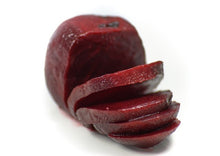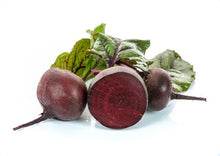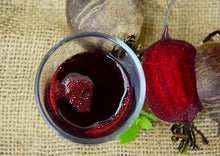Bull’s Blood Beets delivers a nice earthy sweet flavor. The leaves are a deep gorgeous red color. The globe-shaped beet root has deep red with concentric circles – compare to candy-striped Chioggia beet but in a darker version.
It is probably the only decorative-leafed Victorian beetroot variety still being cultivated. Traditionally grown as an ornamental in gardens, but is delicious to eat. Its dark crimson leaves can appear almost black in some light, making a dramatic contrast to most other foliage. The leaves are broader than other beetroot varieties and have a particularly sweet taste when cooked. The medium-sized spherical roots are also dark red, with visible rings when cut. This lovely root is a favorite among beet connoisseurs because it provides a consistently rich and sweet flavor.
They germinate quickly and the plant can grow up to 2-3 feet high and wide. With proper care, a single beet plant can provide an abundant harvest of flavorful leaves and beets for several months.
The heirloom nature of the Bulls Blood beet seeds means that they can be saved from year to year, preserving the genetic diversity, reducing the dependence on commercial seed and promoting organic farming. They are also more resistant to pests and diseases, which makes them ideal for organic gardening.
Planting
- It is recommended to sow beets directly in the garden so that you don’t have to disturb their roots, though beets generally tolerate being transplanted while still young. Start sowing beets in early spring, as soon as the soil is workable.
- Successive plantings are possible as long as daytime temperatures don’t exceed 75°F. Plant every 2 to 3 weeks until about mid-summer timeframe.
- Understand each wrinkle seed actually contains a cluster of about 2 to 4 seeds, so you will need to thin the young plants to 3 to 4 inches apart. Tip:When thinning, don’t pull up the plants, as you may accidentally disturb the roots of the beets. Instead, just snip off the greens.
- Germination is quickly when the soil temperature is warmer (at least 50°F). Tip:To speed up germination, or when planting in areas with low moisture and rainfall, soak the seeds in water for 24 hours before planting.
- Beets are not picky, they can be planted in a location which receives full sun / partial shade.
- Soil should be well prepare, free of rocks to allow develop the bulb properly.
- Caution: when fertilizing make sure the nitrogen is low. Excess nitrogen causes an abundance of leaves (greens) growth and left with small bulbs.
Care
- Thinning is necessary, as you may get more than one seedling out of each seed. When the tops are a 4 to 5 inches tall, thin seedlings to 3 to 4 inches apart. Pinch or cut off the leaves. Pulling them out of the ground may disturb the roots of nearby seedlings.
- Mulch and then water regularly with about 1 inch per week. Beets need to maintain plenty of moisture.
- Weed as needed but be gentle; beets have shallow roots that are easily disturbed.
Common Growing Problems
- Seedlings fail to emerge:Beet seed fail to germinate when the temperatures are high. Mulching keeps bed evenly moist and cooler to encourage seedlings emerge.
- Collapsed seedlings with dark water-soaked stems as soon as emerge: Also called Seeds Rot,this is a fungus that thrives in high humid very moist/soggy soil. Make sure soil is well drained.
- Seedlings are eaten off as soon as they emerge:Presence of cutworms, they chew stems, roots, and leaves. Keep the garden free of weeds.
- Yellowish curled leaves: Possibly shows the presence of Aphids, they are tiny, oval, and yellowish to greenish pear-shaped insects that colonize on the undersides of leaves. They leave behind sticky excrement called honeydew which can turn into a black sooty mold. Use insecticidal soap or neem oil to eliminate them.
- Tiny shot-holes in leaves: Flea beetles are tiny bronze or black beetle a sixteenth of an inch long. They eat small holes in the leaves of seedlings and small transplants. The larvae feed on roots of germinating plants. Spread diatomaceous earth around seedling.
- Small Irregular holes in the leaves.Cabbage looper is a light green caterpillar with yellow stripes running down the back; it loops as it walks. Keep garden clean of debris where adult brownish night-flying moth can lay eggs. Cover plants with spun polyester to exclude moths. Pick loopers off by hand.
- Partially eaten leaves; leaves webbed together:Garden webworms are green with a light stripe about 3/4 inches long; the webworm is the larvae of a brownish yellow moth with gray markings. Clip off & destroy webbed leaves.
- Eaten leaves with Trails of silver slime:Snails and slugs feed on leaves. Reduce hiding places by keeping garden free of debris. Handpick from under boards set in garden as shelter-traps. Crushed egg shells helps naturally eliminates them.
- Trails and tunnels in leaves.The leafminer larvae tunnel inside leaves. Destroy infected leaves and cultivate the garden to destroy larvae and keep adult flies from laying eggs.









